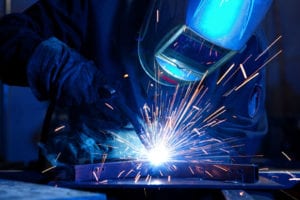Welders and Cutters are considered to be Realistic careers, according to the Strong Interest Inventory® Test. This inventory identifies individuals’ interests and preferences and matches them to careers which will be particularly enjoyable and interesting to them. It was first released in 1927 and has been refined numerous times since then. It is considered among the most universal tools of its kind. The Realistic Theme Code Category centers on physical activity and working with one’s hands to repair things, often while working outdoors. Individuals who score highly in this category enjoy solving specific problems using concrete skills. They are independent workers and thinkers who benefit from a rigid work environment.
Welders, Cutters, and Welder Fitters use hand-welding and flame-cutting equipment to work with metal by either joining different pieces or filling holes or indentations in the surface. They may complete these tasks on flat surfaces, like counters or work tables, vertically against a wall or other surface, or even directly overhead. They first lay out, position, and secure relevant parts before actually assembling them, often using straightedges, rulers, calipers, and other tools. Next, they ensure the surfaces are clean, without slag, rust, or moisture that may interfere with the welding process. Third, they install torches, torch tips, and filler rods to perform the actual task of welding, which they accomplish using blow torches and other tools. They select the exact tools used based on welding chart specifications and the thicknesses of metals being used. As they weld, they monitor the temperature of the metal to ensure its strength. If it becomes too hot or too cold it may become brittle and crack. It may grow or shrink, or the pieces may not be joined strongly. The consequences of uneven heating may vary by metal. Welders commonly work with aluminum, stainless steel, cast iron, and other alloys. Once the task is complete and the welded pieces have cooled, Welders smooth the surface and remove rough spots using portable grinders, hand files, and scrapers.

Learn all about a career as a Welder including career stats such as Median Salary, Daily Tasks, Required Experience, Employment Growth and More!
In addition to the actual mechanics of welding, Welders also may help develop templates and models for projects beforehand, and measure, cut, and bevel metal plates into the shapes specified by the templates. They evaluate their workspace or factory to ensure that they are in compliance with state, local, and federal codes. In case of a fire or other industrial emergency, they use fire suppression methods to ensure safety. Because welding can be highly dangerous, Welders must be detail oriented and able to operate complex equipment easily and safely.
Also, Welders use anvils, cutting dies, flame cutting machines, forklifts, hydraulic presses, brakes, and jacks, and a variety of saws, in addition to measuring equipment, drills, and other power tools. Furthermore, they have to be comfortable using safety equipment like masks, heat and waterproof gloves, goggles, full-body protective gear, and more. In some cases, they may utilize speed sensors, electrodes, generators, threading taps and machines, temperature gauges, and other more specialized equipment. They also rely on a range of different kinds of software, including analytic software (e.g., Scientific Software Group Filter Drain FD), calendar and scheduling software (e.g., OmniFleet Equipment Maintenance Management), and computer aided design (CAD) software (e.g., EZ Pipe), as well as Microsoft Office, record keeping software, and email software.
Most Welders have a strong knowledge of production and processing, especially of raw materials and the manufacture and distribution of goods, as well as of machines and their operation, and design. A solid foundation in mathematics is helpful. Of course, physical coordination, hand/arm steadiness, and near vision are very important, as are the ability to recognize and solve problems. 41% of Welders hold a vocational or post-secondary certificate and 40% hold a high school diploma.
A Welders salary can vary from $25,000 for a new hire in Tennessee to nearly $70,000 for an experienced Welder in Texas, though the national average is $38,150 ($18.34 per hour). Those considering becoming Welders, however, should be aware that location is extremely important. The national growth rate is relatively slow at only 2% to 4%. On the other hand, specific states, especially Rhode Island and Nevada, are projected to have increases in Welder employment near 40% before 2024. Other states out West, including Utah, Colorado, and Arizona, also have projected increases over 20% before 2020. However, welding jobs are becoming scarce in Wyoming, Maine, and West Virginia.
Below are some employment trends for Welders, Cutters, and Welder Fitters:
- Median Salary: $20.43 hourly, $42,490 annually
- Employment: 424,700 employees
- Projected growth (2018-2028): Slower than Average (2% to 3%)
- Projected job openings (2018-2028): 48,800
Visit Our Strong Interest Inventory® Resource Page
Visit Our Myers-Briggs Type Indicator® Career Resource Database for Information on MBTI® Personality Type Careers
To Learn More About the Myers-Briggs Type Indicator, visit our About MBTI Test Page
Click on one of these to access more Realistic Theme Code Careers: Acupuncturist, Airline Pilot, Animal Trainer, Anesthesiologist Assistant, Baker, Barber, Bus Driver, Civil Engineer, Cardiovascular Technologist and Technician, Medical and Clinical Lab Technician, Computer Support Specialist, Game Warden, Forest Firefighter, Heating and Air Conditioning Mechanics, Recreational Protective Service Worker, Meat Trimmer, Molecular and Cell Biologist, Nanotechnology Engineering Technician, Oral and Maxillofacial Surgeon, Pathologist, Plumber, Radiologist, Police Patrol Officer, Surveyor, Telecommunications Engineering Specialist, Veterinarian, Veterinary Technologist and Technician, Welder, Zoologist and Wildlife Biologist.
Explore our Strong Interest Inventory® Blog Pages:
- Strong Interest Inventory Realistic Theme Explained
- Strong Interest Inventory Artistic Theme Explained
- Strong Interest Inventory Investigative Theme Explained
- Strong Interest Inventory Social Theme Explained
- Strong Interest Inventory Enterprising Theme Explained
- Strong Interest Inventory Conventional Theme Explained
Assessment Categories
References
- Bureau of Labor Statistics wage data and 2012-2022 employment projections Onetonline.org









